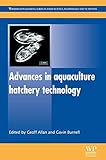Advances in aquaculture hatchery technology / edited by Geoff Allan and Gavin Burnell.
Material type: TextSeries: Woodhead Publishing in food science, technology, and nutrition ; no. 242.Publisher: Oxford : Woodhead, 2013Description: 1 online resource (682 pages) : illustrations (some color), mapsContent type:
TextSeries: Woodhead Publishing in food science, technology, and nutrition ; no. 242.Publisher: Oxford : Woodhead, 2013Description: 1 online resource (682 pages) : illustrations (some color), mapsContent type: - text
- computer
- online resource
- 9780857097460 (e-book)
- Aquaculture hatchery technology
- 639.3 23
- SH135 .A29 2013eb
Includes bibliographical references and index.
part I. Reproduction and larval rearing -- part II. Closing the life-cycle and overcoming challenges in hatchery production for selected invertebrate species -- part III. Closing the life-cycle and overcoming challenges in hatchery production for selected fish species -- part IV. Aquaculture hatcheries for conservation and education.
For seafood production to meet expected demand from a growing global population, many more millions of tons of seafood will need to be produced. The expectations for increased product from capture fisheries is limited, so this rise in production will have to come from aquaculture, one of the fastest growing food producing sectors in the world. A primary constraint to the continuing growth of aquaculture is the supply of juveniles from hatcheries -- Source other than Library of Congress.
Description based on print version record.
Electronic reproduction. Palo Alto, Calif. : ebrary, 2013. Available via World Wide Web. Access may be limited to ebrary affiliated libraries.
There are no comments on this title.
